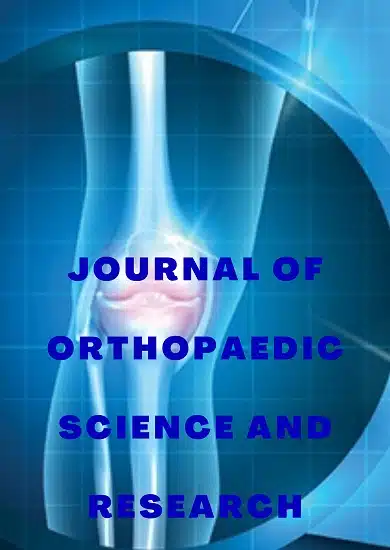Research Article | Vol. 6, Issue 1 | Journal of Orthopaedic Science and Research | Open Access |
In Our Orthopedics and Traumatology Clinic, Cases with Acute Deep Vein Thrombosis in the Upper and Lower Extremities
Ertugrul Allahverdi1*
1Kafkas University Faculty of Medicine, Orthopedics and Traumatology Clinic, Kars, Türkiye
*Correspondence author: Ertugrul Allahverdi, Director, Kafkas University Faculty of Medicine, Orthopedics and Traumatology Clinic, Kars, Türkiye; Email: [email protected]
Citation: Allahverdi E. In our Orthopedics and Traumatology Clinic, Cases with Acute Deep Vein Thrombosis in the Upper and Lower Extremities. J Ortho Sci Res. 2025;6(1):1-8.
Copyright© 2025 by Allahverdi E. All rights reserved. This is an open access article distributed under the terms of the Creative Commons Attribution License, which permits unrestricted use, distribution, and reproduction in any medium, provided the original author and source are credited.
| Received 31 December, 2024 | Accepted 26 January, 2025 | Published 04 February, 2025 |
Abstract
Upper extremity deep vein thrombosis is rare but not unimportant. The current literature is limited and its management largely has the same applications as the treatment of lower extremity deep vein thrombosis. The fact that deep vein thrombosis has similar findings to many different diseases in Orthopedics and Traumatology clinics and that it can develop secondary to primary pathologies should definitely be considered in differential diagnoses. Not considering delayed deep vein thrombosis diagnoses in differential diagnoses may also lead to an increase in patient morbidity and mortality.
Keywords: Acute Deep Vein Thrombosis; Blood Clot; Traumatology Clinic; Thrombin-Activated Fibrinolysis Inhibitor
Introduction
It is emphasized that considering acute deep vein thrombosis findings in the lower and upper extremities of our patients who apply to the emergency services and our orthopedics clinic in differential diagnoses is important in terms of preventing patient mortality and morbidity. In the etiology of thrombosis, hypercoagulability or in other words thrombophilia is used to define the tendency to thrombosis in the coagulation system. Thrombophilia; It is seen at a rate of approximately 5-8% in the USA and most of them are genetic but some can be acquired. Deep vein thrombosis is observed in one in 1000 people every year on average [1]. A second factor is usually required in the formation of thrombosis. There is generally no specific treatment method for thrombophilia, but long-term prophylactic anticoagulation is necessary to prevent recurrent attacks. In the etiology of thrombosis. The risk of blood clot development increases in some coagulation factors (fibrinogen, factor VIII, IX, XI, Thrombin-Activated Fibrinolysis Inhibitor-TAFI), dysfibrinogenemia, plasminogen activator inhibitor-1, lipoprotein (a), diseases that negatively affect all systems such as heart failure, cancer and nephrotic syndrome, use of drugs such as erythropoietin, tamoxifen, thalidomide, surgeries, especially in hip, pelvic bone and knee surgeries and this risk continues in relation to the immobility of the patient during the post-operative recovery period [2-5]. We can list traumas affecting large vessels, hyperhomocystenemia, oral or transdermal contraceptive use, myeloproliferative diseases, paroxysmal nocturnal hemoglobinuria, air travel, travel over 6 hours, living at high altitude, varicose veins, obesity, sedentary lifestyle, smoking addiction, Systemic Lupus Erythematosus, Behcet’s disease and similar dermatological diseases, pregnancy, malignancy, orthostatic hypercoagulability, Protein C and S deficiency [6-15].
Material and Methods
11 patients who were diagnosed with acute deep vein thrombosis for the first time among 1000 patients who applied to Kafkas University Medical Faculty Emergency Department, Orthopedics and Traumatology Polyclinic with pain, swelling and limited movement in the upper and lower extremities between 1/1/2022-13/1/2025 were evaluated in our study. Among our patients diagnosed with thrombosis, cases who applied their treatments regularly and came for at least 6-month check-ups were included in the study. The demographic structure and Frequency Analysis findings of all our patients are given in Table 1.
Variable | n | % |
Gender | ||
Woman | 628 | 62,8 |
Male | 372 | 37,2 |
Age | ||
20-35 | 93 | 9,3 |
36-51 | 428 | 42,8 |
52 and above | 479 | 47,9 |
Marital status | ||
Married | 724 | 72,4 |
Single | 276 | 27,6 |
Educational Status | ||
Primary school | 124 | 12,4 |
Middle school | 211 | 21,1 |
High school | 420 | 42 |
University | 245 | 24,5 |
Working status | ||
Housewife | 546 | 54,6 |
Freelance | 253 | 25,3 |
Institutional | 201 | 20,1 |
Long-term and frequent travel | ||
Yes | 123 | 12,3 |
No | 877 | 87,7 |
Air travel | ||
Yes | 251 | 25,1 |
No | 749 | 74,9 |
Smoking status | ||
Yes | 635 | 63,5 |
No | 365 | 36,5 |
Oral Contraceptive Use | ||
Yes | 238 | 23,8 |
No | 390 | 39 |
Living at High Altitude | ||
Yes | 864 | 86,4 |
No | 136 | 13,6 |
Body mass index | ||
Normal | 613 | 61,3 |
Fat | 276 | 27,6 |
Obez | 111 | 11,1 |
Diyabet Tip 2 | ||
There | 347 | 34,7 |
None | 653 | 65,3 |
Hb and Htc height | ||
There | 421 | 42,1 |
None | 579 | 57,9 |
Table 1: Demographic distributions and percentage frequency values of our patients with upper and lower extremity pain, movement limitation and skin findings (n: 1000).
Results
4 were female (36.36%), 7 were male (63.63%). 2 patients (18.18%) presented with thrombosis symptoms within the first 4 months after orthopedic surgery (1 patient had total knee prosthesis, 1 patient had partial hip prosthesis due to femoral neck fracture). Among our other patients, 3 patients (27.27%) had only supra patellar bursitis and calf pain (Fig. 1-4), 1 patient (9.09%) had acute psoriatic skin symptoms and varicose veins together with supra patellar bursitis and calf pain (Fig. 2), 2 patients (27.27%) had only calf swelling and pain (Fig.1-7), 1 patient (9.09%) had gastrointestinal system and vena cava thrombosis diagnoses while being followed up in the general surgery clinic and had symptoms of bruising and pain in the right hand and arm and 1 female patient (9.09%) had acute pain, swelling, bruising, limitation of movement and increased temperature in the right axillary region, right arm and hand (Fig. 5). One of our patients was diagnosed with below-knee infection and thrombosis (Fig. 6), 4 of our male patients (36.36%) had smoked 1 pack/day/15 years and above, were obese patients with knee prosthesis, 8 of our patients (72.72%) had hypercholesterolemia that could be reduced with diet, 2 of our patients (18.18%) had Type 2 Diabetes and these patients were observed to have Tinea pedis and onychomycosis (Fig. 3,7), 3 of our patients (27.27%) were patients receiving oral anticoagulant treatment. All of our patients were diagnosed with deep vein thrombosis by routine upper and lower Doppler USG (Fig. 8). One patient (9.09%) was a teacher, two patients (18.18%) were waiters, three patients (27.27%) were agricultural workers, one patient (9.09%) was a dentist, one patient (9.09%) was a person who worked in a public institution by sitting for long periods of time and three patients (27.27%) were housewives. The average age of our patients was 55.8. Visible varicose veins below the knee were detected in 4 patients (36.36%). Homans test was positive in 9 patients (81.8%). In our patients with supra patellar bursitis, thrombosis signs and symptoms began to become apparent 2 and 3 weeks after bursitis findings first appeared. Intermittent claudication finding was positive in 11 patients (100%). When our 3 patients (27.27%) applied to the emergency and orthopedic clinics, they were initially diagnosed as infected cases due to increases in white blood cell, CRP and sedimentation in their blood tests and antibiotic treatments were started. However, due to the rapid progression of symptoms after 2-3 days, deep vein thrombosis was diagnosed in the control examinations and lower extremity Doppler USG, D dimer tests in our orthopedic clinic and antibiotic treatments were terminated and antithrombotic treatments were started with vascular surgery consultations. All our patients were started on anticoagulant 6000 IU low molecular weight Heparin and 100 mg acetylsalicylic acid treatment for 6 months and compression stockings were applied to the lower extremities. In 1 of our cases (9.09%), hemogram values were within normal limits, CRP and 39 degrees fever caused respiratory distress due to pulmonary embolism. In 1 of our cases (9.09%), left hemiparesis due to intracerebral micro embolism developed 8 months later and complete recovery without sequelae was achieved with the continuation of anticoagulant treatment and neurology clinic follow-ups.
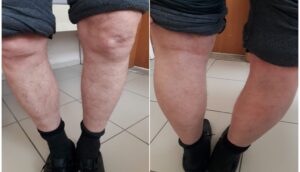
Figure 1: Right sub-knee thrombosis (anterior and posterior).
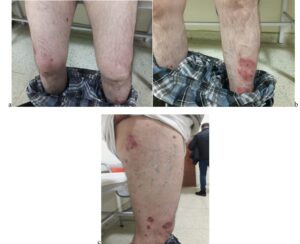
Figure 2: Our patient with varicose veins, psoriatic skin lesions and thrombosis findings on the right leg.
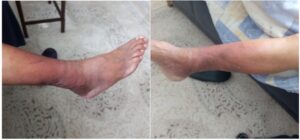
Figure 3: Thrombosis in a diabetic patient below the right knee.
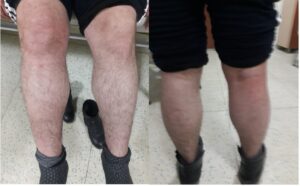
Figure 4: Right supra patellar bursitis and right sub-knee thrombosis.
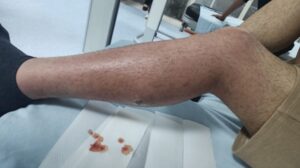
Figure 5: -Diabetic patient and Thrombosis with soft tissue infection.
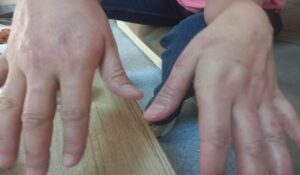
Figure 6: Axillary deep vein thrombosis with pain, bruising and hypoesthesia in the right hand.
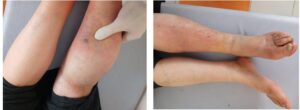
Figure 7: There is acute venous thrombosis and Homans sign below the left knee, onychomycosis in the left big toe.
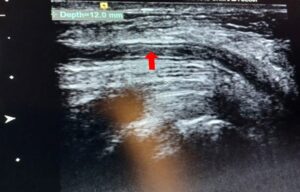
Figure 8: Vascular thrombosis finding in the Doppler USG of our diabetic patient’s lower extremity (arrow).
Discussion
In the field of Orthopedics and Traumatology, pre- and post-operative, especially in upper and lower extremity closed fractures over the age of 16, blunt traumas, in immobilizations with short or long leg circular casts and splints for the lower extremities, in diabetes, skin diseases and in upper and lower extremity pathologies of tumors, pre- and post-operative anticoagulant and/or antiaggregant treatments should be applied [10-13]. Due to the potential for the development of atherosclerosis and atheroma plaques due to vasculopathies in diabetic patients, regular blood sugar monitoring, clinical and radiological examinations should be performed systematically [3,10-12]. In our clinic and other studies, regular hemogram, PTT, INR, D clinical correlations with dimer, CRP, sedimentation follow-ups, regular check-ups of metabolic diseases and continuous use of antithrombotic knee-high socks have significantly reduced the development of deep vein thrombosis [10,11]. Controlled antithromboembolism treatments should be applied for 6 months without interruption until patients are actively fully mobilized. In most of our cohart patients in our study group, high weight index for height, being in the middle age group, diabetes and smoking and high Hb, Htc values due to living at high altitude are predisposing factors for the development of deep vein thrombosis. Studies in the literature also support our findings [1,3,6,21]. In one of our cases with proximal femur fracture and partial prosthesis surgery, pulmonary embolism due to respiratory distress was diagnosed in CT scans within the first 2 weeks postoperatively and respiratory functions were partially improved with intensive care follow-up and anticoagulant treatments. In clinical studies, it is stated in the literature that thrombosis cases may develop within the first 14 days after arthroplasties at a rate of 2-4% [9-11]. Deep vein thrombosis can cause pulmonary embolism with a primary focus and frequently repeated pulmonary thromboembolisms can cause deep vein thrombosis [9]. In one of our cases, neurological complications due to acute intracerebral embolism were observed in the later period due to the termination of the given treatment in the 6th month based on control examinations.
In this case, the symptoms due to the restart of anticoagulant treatment regressed within 2 months and the treatment without sequelae continues with oral anticoagulants. In the literature, it has been observed that oral anticoagulants affecting oral Factor V (a) are more effective than low molecular weight heparin treatment according to the criteria of adequate renal function [10,11]. Especially sedentary lifestyle, smoking, high dose alcohol use, obesity, high blood sugar and HbA1C values, hypercholesterolemia are factors that increase the prevalence of acute thrombosis etiology [1-3,13-15]. Considering these cases, acute deep vein thrombosis should be considered in the differential diagnosis in cases of difficulty in walking, posture disorder, popliteal and significant knee and ankle pain, antalgic walking due to leg pain, especially calf pain, need to sit and rest, sudden pain and swelling in the arm, bruising after redness and sensory deficits. Thrombosis is most frequently seen within the first 2 months of catheterization [17,18]. In our study, it is known that 3 of our patients had cardiac catheterization and stent application in their medical history. The results of oral contraceptive use on the risk of upper extremity deep vein thrombosis are contradictory [6]. The risk of upper extremity deep vein thrombosis increases 5-fold in prothrombin G20210A and natural anticoagulant deficiencies and 6-fold in those with factor V Leiden mutations [16]. The incidence of upper extremity deep vein thrombosis may increase due to cardiac catheter and pacemaker applications [17,18]. In our upper extremity deep vein thrombosis cases, there was no history of cardiac catheter, surgery or plaster splint application. However, one of our cases had portal vein thrombosis. It has been determined that thrombosis formation due to cardiac catheterization and upper extremity plaster and surgical interventions increases 7 to 13-fold [18]. Spontaneous or anatomical anomalies-related shoulder girdle syndrome, Paget-von Schroetter syndrome (PSS; thrombosis of the subclavian vein in thoracic outlet syndrome), cervical rib, exostoses, clavicle fractures and hypertrophy of the scalene muscle are also causes of acute thrombosis [16,19,20]. In our study cohort group, upper extremity fractures, luxations, surgical interventions and acute deep vein thrombosis of the upper extremities due to casting were not encountered.
Conclusion
In case of axillary, cervical, shoulder area pain, movement restrictions, physical examination, palpation, laboratory tests should be performed to check hemogram, CRP, sedimentation, D Dimer values in terms of deep vein thrombosis due to vascular structure pathologies in axillary, subclavian, jugular veins and lower and upper extremity Doppler ultrasonography examinations should be performed urgently. Increases in the frequency of epidemics and pandemics, some immune vaccines may increase the prevalence of thromboembolism [22]. It was determined that ¾ of our cohort group patients had received Covid vaccination and/or had Covid. The region where our patients live is 1768 m above sea level in terms of altitude and some regions are living places at an altitude of 2000 m to 2200 m. In addition to the effects of high altitude, the frequency of diabetes, smoking and high weight rates increase the frequency of our acute deep vein thrombosis cases. Therefore, in settlements where such predisposing factors exist, the role of preventive health policies and education is extremely important in terms of preventing or reducing the frequency of thromboembolism and secondary pathologies that may occur. Mortality and morbidity after acute thrombosis are increasing in our region as in other societies around the world and economic and psychosocial problems are increasing accordingly.
Conflict of Interests
The authors declare that they have no conflict of interest in this paper.
References
- De Moerloose P, Alhenc-Gelas M, Boehlen F, Bounameaux H, Aiach M. Semin Vascd deep venous thrombosis and thrombophilia: indications for testing and clinical implications. Med. 2001;1(1):89-96.
- Simioni P. X-linked thrombophilia with a mutant factor IX (factor IX Padua). N Engl J Med. 2009;361:1671-5.
- Sveinsdottir SV, Svensson PS, Engstrom G. Inflammatory plasma markers and risk for venous thromboembolism. J Thromb Thrombolysis. 2014;38:190-5.
- O’Donnel J. High prevalence of elevated factor VIII levels in patients referred for thrombophilia screening: Role of increased synthesis and reletionship to the acute phase reaction. Thromb Haemost. 1997;777-825.
- Bouma BN. Thrombin-Activatable Fibrinolysis Inhibitor (TAFI). Thromb Haemost. 2003;1:1566.
- Luxembourg B, Schmitt J, Humpich GM, Seifried E, Lindhoff‐Last E. Intrinsic clotting factors in dependency of age, sex, body mass index and oral contraceptives: definition and risk of elevated clotting factor levels. Blood Coagul Fibrinolysis. 2009;20:524-34.
- Ohira T, Cushman M, Tsai M, Zhang Y, Heckbert SR, Zakai NA, et al. ABO blood group, other risk factors and incidence of venous thromboembolism: the Longitudinal Investigation of Thromboembolism Etiology (LITE). J Thromb Haemost. 2007;5:1455-61.
- McGill JB. Factors responsible for impaired fibrinolysis in obese subjects and NIDDM patients. Diabetes. 1994;43:104-9.
- Leal N, Freitas A, Leal F, Pimenta J, Gregório T Risk factors for chronic thromboemboli after pulmonary thromboembolism. Eur J Intern Med. 2022;102:133-5.
- Jones A, Al-Horani RA. Venous thromboembolism prophylaxis in major orthopedic surgeries and factor XIa inhibitors. Med Sci (Basel). 2023;11(3):49.
- Majima T, Oshima YJ. Venous thromboembolism in major orthopedic surgery. Nippon Med Sch. 2021;88(4):268-72.
- Ingrassia JP, Maqsood MH, Gelfand JM, Weber BN, Bangalore S, Lo Sicco KI, et al Cardiovascular and venous thromboembolic risk with jak inhibitors in immune-mediated inflammatory skin diseases: a systematic review and meta-analysis. JAMA Dermatol. 2024;160(1):28-36.
- Brecher CW, Lang EV. Tumor thromboembolism masquerading as bland pulmonary embolism. J Vasc Interv Radiol. 2004;15(3):293-6.
- Hilmen P. Natural history of paroxysmal nocturnal hemoglobinuria. N Engl J Med. 1995;33:1253.
- Chandra D. Meta-analysis: Travel and risk for venous thromboembolism. Ann Intern Med. 2009;151:212.
- Grant JD, Stevens SM, Woller SC. Diagnosis and management of upper extremity deep-vein thrombosis in adults. JTH. 2012;108:1097-108.
- Evans RS, Sharp JH, Linford LH. Risk of symptomatic DVT associated with peripherally inserted central catheters. Chest. 2010;138:803-10.
- Da Costa SS, Scalabrini Neto A, Costa R, Caldas JG, Martinelli Filho M. Incidence and risk factors of upper extremity deep vein lesions after permanent transvenous pacemaker implant: a 6-month follow-up prospective study. Pacing Clin Electrophysio. 2002;25:1301-6.
- Cote LP, Greenberg S, Caprini JA. Comparisons between upper and lower extremity deep vein thrombosis: a review of the RIETE registry. Clin Appl Thromb Hemost. 2016.
- Heil J.Miesbach W, Vogl T. Bechstein W O ,Reinisch A. Deep vein thrombosis of the upper extremity: A systematic review. Dtsch Arztebl Int. 2017;114(14):244-9.
- Bethany LW, Marcus L, Tyler S. Elevated hematocrit enhances platelet accumulation following vascular injury. Blood. 2017;129(18):2537-46.
- Pishko AM, Cuker A. Thrombosis after vaccination with messenger RNA-1273: Is this vaccine-induced thrombosis and thrombocytopenia or thrombosis with thrombocytopenia syndrome? Ann Intern Med. 2021;174:1468-9.
Author Info
Ertugrul Allahverdi1*
1Kafkas University Faculty of Medicine, Orthopedics and Traumatology Clinic, Kars, Türkiye
*Correspondence author: Ertugrul Allahverdi, Director, Kafkas University Faculty of Medicine, Orthopedics and Traumatology Clinic, Kars, Türkiye; Email: [email protected]
Copyright
Ertugrul Allahverdi1*
1Kafkas University Faculty of Medicine, Orthopedics and Traumatology Clinic, Kars, Türkiye
*Correspondence author: Ertugrul Allahverdi, Director, Kafkas University Faculty of Medicine, Orthopedics and Traumatology Clinic, Kars, Türkiye; Email: [email protected]
Copyright© 2025 by Allahverdi E. All rights reserved. This is an open access article distributed under the terms of the Creative Commons Attribution License, which permits unrestricted use, distribution, and reproduction in any medium, provided the original author and source are credited.
Citation
Citation: Allahverdi E. In Our Orthopedics and Traumatology Clinic, Cases with Acute Deep Vein Thrombosis in the Upper and Lower Extremities. J Ortho Sci Res. 2025;6(1):1-8.

